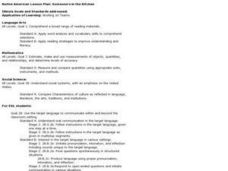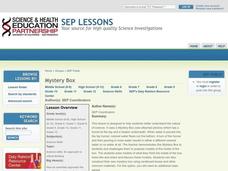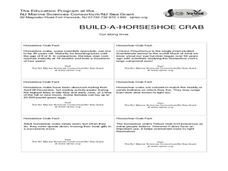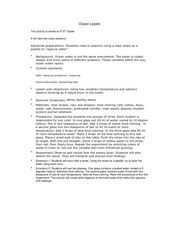Curated OER
Growing A Coral Skeleton
Students research the growth of coral. In this coral polyps lesson, students simulate the growth of coral by using available materials to grow crystals. Students record observations in a scientific journal.
Curated OER
Seed Types
Students dissect seeds. In this seed dissection lesson plan, students discover the anatomy of seeds. After dissecting seeds, students hypothesize and design the perfect seed to survive in a dry forest.
Curated OER
The Differences Between Turtles and Tortoises
First graders differentiate between turtles and tortoises. In this turtles and tortoises lesson plan students are visited by a turtle and a tortoise. Students write a letter with an illustration after the animals visit the class.
Curated OER
ESL Activity - Authentic Cooking Experience
Students encounter imperatives used for the instructions for this cooking experience. They review selected vocabulary terms for food and the process of cooking. Students identify adverbs of sequence (first, then, etc.). They follow the...
Curated OER
Field Trip!: A Visit to the Grocery Store
Students discover that foods are organized into groups of similar items by developing vocabulary to enhance verbal discussion i.e., real experiences provide the foundation for thoughtful discussion and critical thinking. They then...
Curated OER
Nutrition: Gregory the Terrible Eater
Students listen to a story about a goat who craves human food. They discover the four basic food groups and discuss what they might eat if they were terrible eaters. Students retell the story by looking at the pictures. They complete...
Curated OER
Native American Lesson Plan: Someone's in the Kitchen
Students use vocabulary necessary to complete cooking activities and tell others about the food. They discuss similarities and differences between Native American and other nationalities' foods made in their families.
Curated OER
Parent and Baby Lookalikes
Students research baby animals, their special names and the vocabulary to describe their relative sizes through discussion, listening to a Salish story, looking at pictures, and creative artwork . They will also explore the significance...
Curated OER
Children's Literature Across the Curriculum Ideas-Ira Sleeps Over
Students read Ira Sleeps Over by Bernard Waber. They complete a variety of cross-curricular activities surrounding the ideas presented in the story. Included are reading, art, math, science, writing, social studies, and library...
Curated OER
Mystery Box
Students explore why scientists use models to help them explain things that cannot be seen. In this predictions lesson students make a prediction based on observations and collected evidence.
Curated OER
From Corn To Tortillas
Students investigate the food known as the tortilla. They research the growth cycle of the corn plant and how tortillas are made from it. The importance of the tortilla according to the Hispanic culture is explained to the students. The...
Curated OER
Saving Big Cats from Extinction
Students explore extinction. In this biology and environmental science lesson, students define extinction, identify what living things need to survive, and create a persuasive poster about "saving the big cats" using a desktop...
Curated OER
Build-A-Horseshoe Crab
Students discover many facts about horseshoe crabs. Students identify the main body parts of horseshoe crab. They explore the habits of the horseshoe crab and their importances to the ecosystem. Adaptations for younger students are...
Curated OER
Understanding Interactions Among Local Species and the Local Environment
Students examine the differences between biotic and abiotic factors, explain the difference between habitat and niche and compare how organisms get their nutritional needs. In this local environment instructional activity students...
Curated OER
Ocean Layers
Young scholars investigate how temperature and salinity causes ocean layering. In this ecology lesson, students observe and sketch their experimental result. They report their findings in class.
Curated OER
All About Ants
Students create model ants in order to study the characteristics of insects such as body segments, number of legs, and feelers, as well as how these characteristics serve the insect.
Curated OER
WHERE'S THE BEEF?
The student will become visually aware of the different shapes of wholesale cuts of beef.1. Ask a local meat cutter to make a class visit to explain his or her job. 2. Enlarge the steer outline on Student Worksheet B, and place it on a...
Curated OER
Cranes, Crosswalks, and Big Gulps
Students watch a video and answer questions based on wildlife jobs. In this wildlife lesson plan, students learn that biologists don't just play with animals but that there is a lot of study involved.
Curated OER
$$$eaweed
Students compare and evaluate the world's different seaweeds. In this investigative instructional activity students study seaweed and the harvesting of it. They then interpret the data collected and graph the seaweed...
Curated OER
Root, Root, Root for the Nutrients
Pupils observe the growth of a seed, predict what will happen when seeds are planted without soil, and conduct an experiment using a hydroponics system.
Curated OER
Podcasting Crusader's Style
Students work as a group of scientists studying a specific biome of their choice. In this biome lesson, students research a biome and develop a podcast where factual information is read about a biome and the events of...
Curated OER
Living With the Heat: The Ring of Fire
Students investigate the planet Earth's infamous ring of fire and the life that thrives from it. In this ocean environment lesson, students investigate hydrothermal vents and how organisms thrive off their heat. Students...
Curated OER
Biodiversity in Illinois-Pond Habitats
Second graders construct a pond habitat in the classroom using a small swimming pool partially filled with water, real cattails, a tree log adjoining, and plastic animal life appropriate to a pond setting. They examine the frog in detail...
Curated OER
Arbor Day
First graders study the importance of trees to our environment. they make their own version of the story by completing the following sentence and then completing an illustration for their writing. "A tree can be ______."























